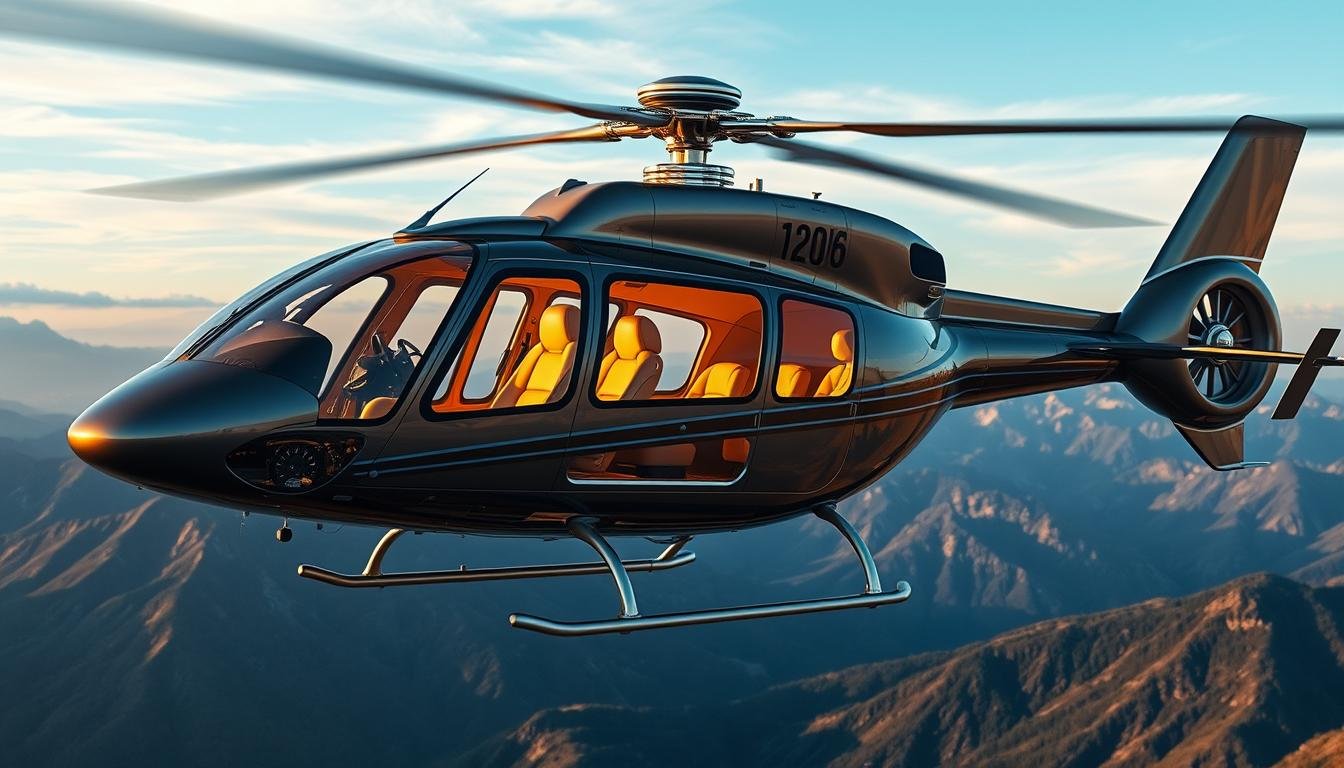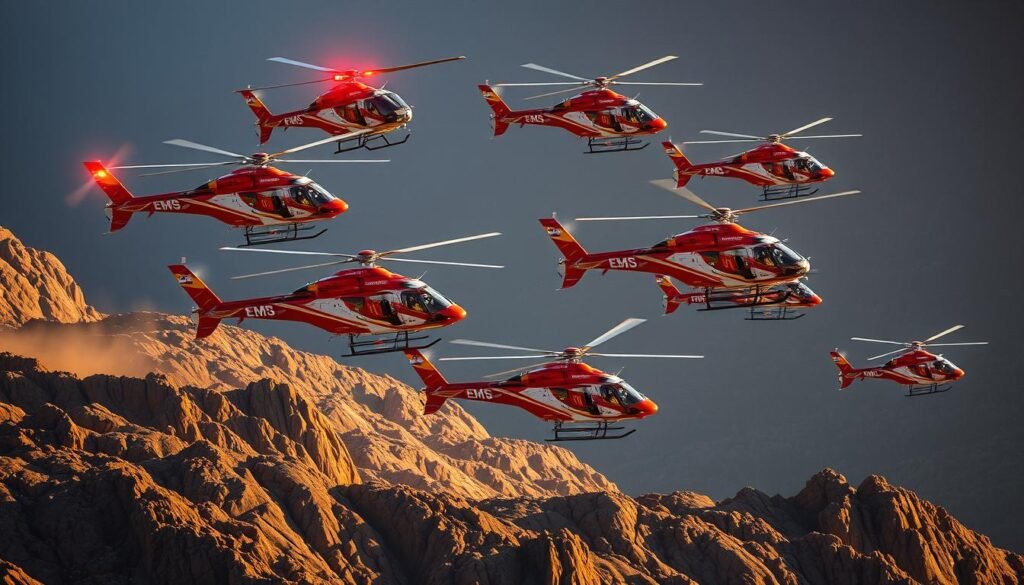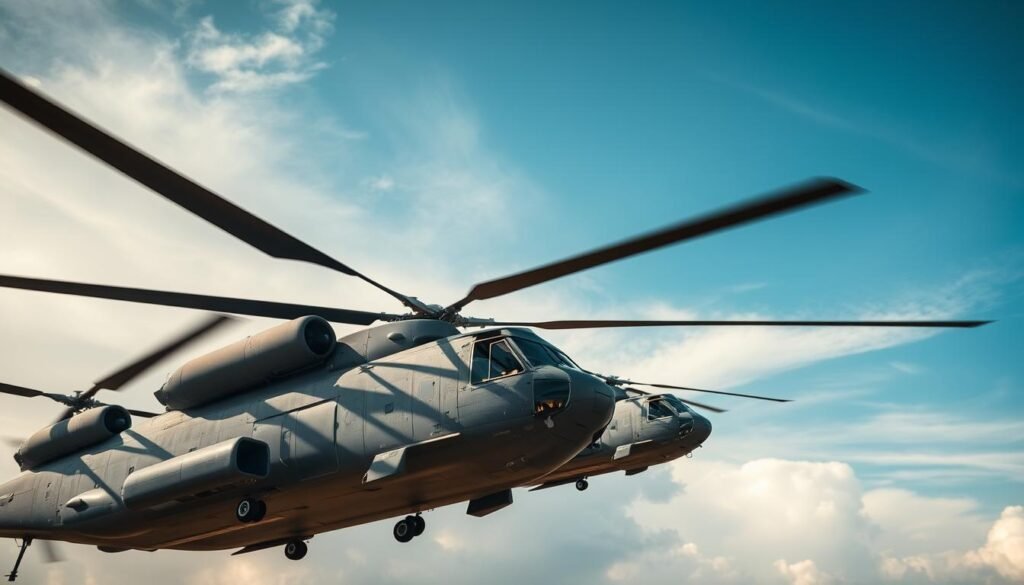Luxury helicopters now blend city-center access with interiors that rival small private jets.
More than 70% of executive transfers under 500 miles favor rotorcraft for faster door-to-door time, thanks to rooftop landing options and shorter ground transfers.
These aircraft pair advanced avionics like synthetic vision and four-axis autopilots with low-vibration Fenestron tails and soundproofed cabins.
Passengers find configurable seating, large double-pane windows, mini-bars, and electro-chromatic glass that lift the in-flight experience to a new level.
This roundup focuses on operationally meaningful specs: cruise speed, usable range, seating, and the unique features that matter for business travel and leisure.
Key Takeaways
- Rotorcraft offer true point-to-point advantage for urban and regional travel.
- Buyers should weigh speed, range, and cabin class when comparing aircraft to a private jet.
- Top models bring jet-like avionics and quiet cabins for a refined passenger experience.
- Operational specs — cruise mph, range, and seats — make side-by-side comparisons easier.
- Safety systems like TCAS II and synthetic vision elevate performance in varied conditions.
Luxury Helicopters Overview For Today’s Private And Business Travel
Executive rotorcraft routinely close the gap on door-to-door travel in busy city pairs and sub-500-mile regional runs. They lift from rooftop pads and constrained sites to cut ground transfers and maximize on-site time for business travel.
Modern flight systems — four-axis autopilots, synthetic vision, and TCAS II — provide jet-like redundancy and improved situational awareness for pilots. These systems make complex urban approaches safer and more predictable.
Cabin design focuses on comfort and productivity. Soundproofing, double-pane windows, and tailored layouts support four to twelve passengers with room for baggage and work accessories.
- Typical speed and range figures cover short to mid-range missions measured in miles, placing most meetings and resorts within a single flight.
- Payload and seating balance legroom, baggage, and mission-specific fit-outs for VIP and business operations.
- Urban landing flexibility supports rooftops, hospital pads, estates, and FBO helipads where allowed.
Buyers and charter planners often start with a matrix of speed, range, seats, and operating environment to match an aircraft to mission needs. For listings and acquisition options, see VIP and private listings.
Luxury Helicopters: Flagship Models With Elite Specs And VIP Cabins
Leading airframes deliver measurable speed and range while prioritizing cabin comfort and mission flexibility. Below are concise profiles of flagship models that balance system depth with guest-facing features for executive and charter use.

Airbus ACH160 Exclusive
The ACH160 pairs a low-vibration Fenestron with Helionix and a four-axis autopilot. It cruises near 178 mph, covers 460 nm, and seats about 10 passengers.
Large double-pane windows and robust soundproofing preserve privacy and comfort.
Leonardo AW609 Tiltrotor
The AW609 blends VTOL agility with turboprop speed—about 310 mph—and a 700 nm range. A pressurized VIP cabin supports up to eight with optional galley and lavatory.
Sikorsky S-92 Executive
The sikorsky s-92 executive variant offers the largest cabin in class with stand-up height and 14 large windows. It cruises near 174 mph, has a 547 nm range, and includes TCAS II, weather radar, and a four-axis autopilot for jet-like handling.
Airbus ACH175
The ACH175 emphasizes long-range comfort: 174 mph cruise, 613 nm range, and up to 12 seats in three layouts. Its entertainment and environmental systems support longer nonstop missions.
Bell 525 Relentless
The bell 525 features the Garmin G5000H glass deck and protective terrain systems. With a 184 mph cruise and 629 nm range, the cabin doubles as an in-flight entertainment lounge—hence the bell 525 relentless reputation.
Leonardo AW189
The AW189 delivers five-blade smoothness, room for up to 14, and open-architecture avionics. It cruises near 182 mph with a 507 nm range and useful APU-driven pre-flight climate control.
ACH130 Aston Martin Edition
The ach 130 aston martin edition marries DB11-inspired detailing with refined materials. It offers about 134 knots cruise, a 347 nm range, and highly curated customization options for clients seeking standout design on an expensive helicopter list.
For model comparisons and acquisition options, see flagship model listings.
Premium Charter Staples In The United States: Speed, Range, And Seating That Deliver
U.S. charter operators favor a small group of agile rotorcraft that balance speed, range, and cabin comfort for routine VIP transfers. These models hit practical mission numbers without over‑specifying the aircraft.
Bell 407: High Speed, Low Noise, And Smooth Ride For VIP Transfers
The Bell 407 carries 1 pilot + 6 passengers, cruises near 153 mph, and offers about 388 miles of range. Its quiet four-blade composite rotor gives a smooth, low-noise flight suited to urban hops and private estates.
Airbus H130: Panoramic Windows, Near-Silent Flight, And Business-Class Seating
The H130 seats 1 + 6, cruises roughly 149 mph, and reaches about 400 miles. Extra-large windows and a near-silent engine create a cabin with business-class comfort for sightseeing and executive shuttles.
Airbus H125: Safran Arriel Power And Record-Setting High-Altitude Capability
The H125 seats 1 + 5, cruises near 153 mph, and has about 391 miles of range. Powered by the Safran Arriel 2D, it holds the highest-altitude landing record on Mount Everest, a proof point for mountain and hot‑and‑high ops.
- Practical Numbers: Typical cruise speeds around 149–153 mph and ranges near 388–400 miles place many U.S. city pairs within direct reach.
- Mission Fit: With 5–6 passengers plus a pilot, these helicopters meet most premium transfer needs; operators step up to larger types like the Sikorsky S-92 when payloads grow.
Performance, Comfort, And Safety Features That Define First-Class Rotorcraft
High-performance rotorcraft now offer the range and onboard systems that make multi-city trips routine. Owners and operators value measured performance, evidenced by cruise numbers in mph and mission ranges that span several metro areas without refueling.
Range And Speed: From City Hops To 600+ Nautical-Mile Missions
Speeds and endurance vary by model: the Bell 525 posts about 184 mph and 629 nautical miles, while the ACH175 and S-92 Executive cruise near 174 mph with ranges of 613 and 547 nm respectively.
These figures translate into reliable schedules and fewer fuel stops on flights that would otherwise require connections by other aircraft types.
Cabin Experience: Soundproofing, Double-Pane Windows, And Seating For Up To 16 Passengers
Cabin design targets quiet comfort. Engineered soundproofing and double-pane windows reduce noise and improve climate control.
Seating layouts scale from compact VIP shuttles to configurations that carry up to 16 passengers on the Bell 525, all while preserving legroom and storage for luggage.
Advanced Avionics: Synthetic Vision, TCAS II, And Four-Axis Autopilot For Jet-Like Confidence
Avionics suites deliver layered safety. Synthetic vision, TCAS II, and four-axis autopilots reduce pilot workload and standardize procedures in varying conditions.
The 525 relentless highlights a G5000H touchscreen deck and protective terrain functions that improve situational awareness during demanding segments.
Entertainment And Connectivity: Wi‑Fi, Moving Maps, And Electro‑Chromatic Windows
State-of-the-art entertainment systems keep passengers informed and connected with Wi‑Fi, moving maps, and streaming options. Electro‑chromatic glass adds instant light control and privacy.
For buyers weighing systems and cabin scale, the Airbus H160 systems provide a useful reference for integrated environmental and connectivity features.

- Performance envelopes support dependable regional operations measured in miles and nautical miles.
- Cabin features focus on comfort and scalable seating plans to suit mission needs.
- Advanced avionics and entertainment systems combine to deliver a first-class flight experience.
Operating Costs And Customization Options For VIP And Business Owners
Operating costs hinge on engine choice, maintenance cadence, and mission profile. Owners who fly short, frequent sectors face different expense curves than those who operate longer, fewer-cycle flights.
Cost Drivers: Engines, Maintenance, And Mission Profile Impact On Operating Costs
Engine make (Safran, Rolls‑Royce) affects fuel burn, overhaul intervals, and parts prices. Maintenance cycles, parts availability, and local support networks shape downtime and hourly costs.
Utilization matters: high-cycle shuttle work raises inspection frequency and cost per flight hour.
Custom Interiors: Leather Armchairs, Mini-Bars, Privacy Windows, And Brand Editions
VIP owners choose customization options such as leather armchairs, modular seats, mini-bars, and electro-chromatic windows. The ACH130 Aston Martin Edition shows how a branded finish can lift resale appeal.
The S-92’s Marine One lineage proves high-security systems can be integrated without losing passenger comfort.
“A thoughtful completion balances weight, utility, and brand presence to protect long-term value.”
- System selections (connectivity, entertainment) raise acquisition and upkeep costs.
- Seats and passengers configurations must match baggage and mission length.
- Executive lavatories and refreshment centers add function while affecting weight budgeting.
| Factor | Impact On Operating Costs | Typical Customization Tradeoffs |
|---|---|---|
| Engine Type | Fuel burn, TBO, parts cost | Higher-performance engines raise hourly costs |
| Utilization | Inspection cycles, component life | Frequent cycles favor simpler interiors for serviceability |
| Completion Package | Acquisition cost, maintenance complexity | Leather, mini-bars, privacy windows increase value and upkeep |

For operators evaluating charter vs ownership costs, see a practical primer on what it costs to rent to compare real-world hourly economics.
Model Matchmaking: Choose The Right Aircraft For Business Travel, VIP Charters, And Scenic Flights
A clear mission brief—how many passengers, how far, and where you’ll land—makes aircraft choice straightforward.
Compact groups find the Robinson R44 (1+3) offers an affordable, agile option for short leisure hops with ~120 mph and about 350 miles of range.
Executives who want turbine power can step to the Robinson R66 (~137 mph, 373 miles) or Bell 206 Jet Ranger (~127 mph, 431 miles) for added speed without excess capacity.

- The Bell 206 LongRanger and Bell 407 extend capacity to 6 passengers and practical range for frequent business travel or resort transfers.
- Airbus H125, powered by Safran Arriel, stands out for mountain work and high-altitude ops; the H130 adds wider cabin comfort and panoramic windows for a superior passenger experience.
- Style-forward buyers seeking branded finish and turbine reliability should consider the ACH 130 for flexible mission capability.
| Model | Seats | Speed / Range |
|---|---|---|
| Robinson R44 | 1+3 | ~120 mph / ~350 miles |
| Robinson R66 | 1+4 | ~137 mph / ~373 miles |
| Bell 206 Jet Ranger | 1+4 | ~127 mph / ~431 miles |
| Bell 206 LongRanger / Bell 407 | 1+6 | ~137–153 mph / ~388–432 miles |
| Airbus H125 / H130 | 1+5 / 1+6 | ~153 / ~149 mph · ~391 / ~400 miles |
Match mph, range, and seats to mission profiles—city shuttles, weekend coastal travel, or regional meetings—to secure the right travel choice and landing suitability for each flight.
How These Helicopters Compare To Private Jets For Short-Haul Executive Travel
When surface congestion is the bottleneck, short trips often favor direct pad access rather than runway‑dependent routing. This changes the performance equation for business travel under about 500 miles.

Urban Access And Landing Flexibility Under 500 Miles
Helicopters reach helipads and constrained sites that a private jet cannot. That landing flexibility cuts long ground transfers and speeds total journey time in dense metro corridors.
For point‑to‑point trips under ~500 miles, direct rooftop or downtown pad access often outweighs the jet’s higher cruise speed.
Time Savings In High‑Density City Pairs And Remote Destinations
Time‑sensitive business travel benefits from fewer transfers and faster access to meetings. Large executive rotorcraft like the Bell 525 (184 mph, 629 nm) and the Sikorsky S-92 (174 mph, 547 nm) narrow the comfort and systems gap with jets.
Panoramic models such as the H130 add sightseeing value that jets cannot match at low level. Operators also use mixed‑mode itineraries: a jet for long haul, and a helicopter for final distribution to pads or resorts.
- Access beats cruise: pad availability and ground‑time compression often matter more than top speed.
- Operational reach: helicopters serve remote sites and estates without runways.
- Executive image: branded interiors—even Aston Martin‑inspired trims—preserve class when clients join the final leg.
For buyers comparing aircraft and outfitting choices, see this buyers’ guide for acquisition and feature considerations.
Final Thoughts
Today’s fleet of high-end rotorcraft blends measurable performance with cabin finishes designed for comfort and productivity.
From the ACH160 and ACH175 to the sikorsky s-92 Executive, AW609, Bell 525, AW189 and the ACH130 Aston Martin Edition, operators get mph and range figures that match real mission needs. Cabins support up to 16 passengers with double-pane windows, connectivity, and privacy systems.
For U.S. routes, practical types such as the Bell 407, H130, and H125 keep tours and transfers reliable. See comparative scenic tour models for more context at scenic tour models.
Choosing the right option from this expensive helicopter list aligns seats, range, and systems to deliver time savings, cabin comfort, and consistent VIP service.
FAQ
What range and cruise speed can executives expect from flagship rotorcraft like the ACH160, AW609, and Sikorsky S-92?
Modern models offer varied performance. The ACH160 and ACH175 focus on efficient city-to-city hops with cruise speeds around 140–160 mph and ranges near 300–500 miles depending on payload. The AW609 tiltrotor delivers turboprop-like cruise speed (200+ mph) with vertical takeoff capability, extending effective mission range. The Sikorsky S-92 is designed for long overwater and executive missions, with cruise speeds around 160–180 mph and ranges over 600 miles when outfitted for extended missions.
How do cabin features differ between an ACH130 Aston Martin Edition and a Bell 525 Relentless?
The ACH130 Aston Martin Edition emphasizes bespoke automotive-grade finishes, ergonomic supercar seats, and tailored trim for an ultra-stylized VIP feel. The Bell 525 emphasizes a larger cabin footprint, configurable lounge layouts, advanced G5000H avionics integration, and robust in-flight entertainment for group transfers and executive meetings in the air.
What safety and avionics systems deliver jet-like confidence in these rotorcraft?
Top models use synthetic vision, traffic collision avoidance (TCAS II), four-axis autopilots, and integrated flight decks such as Helionix or Garmin/G5000H suites. These systems reduce pilot workload, improve situational awareness, and enable stabilized approaches and precision navigation comparable to turbine business jets.
Can a tiltrotor like the AW609 replace a private jet for short- to mid-range executive missions?
For missions under about 500 miles, the AW609 can match or exceed jet trip times by combining VTOL access with turboprop cruise speed. It excels where runway access is limited and where direct point-to-point routing saves ground transfer time. However, jets still lead for higher altitudes, pressurization comfort for longer runs, and economies on very long trips.
What seating capacity and cabin layout options are common for VIP and corporate configurations?
Configurations vary from single-pilot executive shuttles seating 4–6 to large executive cabins accommodating 12–16 passengers in aircraft like the S-92. Owners can choose club seating, conference tables, divans, or sleeper modules. Modular systems permit rapid reconfiguration between passenger, medevac, and cargo missions.
How do operating costs compare across high-end light and medium twin models?
Direct costs depend on engine type, maintenance schedule, and utilization. Light turbos like the Safran Arriel-powered H125 or H130 have lower hourly fuel and maintenance bills but lower payload and range. Medium twins and large platforms incur higher hourly maintenance and fuel costs, especially for multi-engine systems and complex avionics, but provide greater range, payload, and mission flexibility.
What customization options are available for VIP interiors and on-board systems?
OEMs and completions centers offer leather seating, ambient lighting, mini-bars, noise reduction packages, electro-chromatic windows, and integrated Wi‑Fi and moving-map entertainment. Brand collaborations — such as automotive editions — provide bespoke materials and trim. Avionics and cabin management systems are tailored to owner preferences.
Are panoramic windows and low cabin noise standard on models used for scenic or charter work?
Panoramic glazing and enhanced soundproofing are common on tour and charter-focused types like the H130 and Bell 407. These features improve passenger experience for sightseeing and VIP transfer missions; options often include upgraded insulation, vibration dampers, and quieter rotor or fenestron designs.
What role does maintenance infrastructure play when selecting a model for U.S. charter operations?
Readily available parts, factory support, and trained technicians reduce downtime and operating risk. Models with broad U.S. service networks — Airbus H125/H130 series, Leonardo AW189, Bell platforms, and Sikorsky — typically offer faster turnarounds and predictable maintenance costs, which is critical for charter reliability and regulatory compliance.
How do these rotorcraft handle urban access and landing flexibility compared with small jets?
Rotorcraft can access rooftop pads, heliports, and remote sites without runways, dramatically reducing door-to-door travel time in dense metros. That flexibility makes them superior for sub-500-mile routes where time savings and direct access outweigh the higher hourly operating cost versus fixed-wing aircraft.
What should an operator consider when choosing between single-engine light types and multi-engine medium aircraft?
Consider mission profile, passenger count, range, and regulatory environment. Single-engine light types offer lower hourly operating costs and excellent maneuverability for short hops. Multi-engine mediums deliver redundancy, higher payload, and longer range, making them preferable for overwater flights, larger groups, and more demanding corporate missions.
Do interior entertainment and connectivity systems meet corporate IT security and conferencing needs?
Modern cabin systems include secure Wi‑Fi, satellite comms, encrypted voice/data links, and conferencing suites with noise-canceling mics. Buyers can request enterprise-grade routers and VPN integration to satisfy corporate IT policies and enable productive in-flight meetings.
Which models are frequently chosen for U.S. VIP charters and corporate shuttle services?
The Bell 407 and Airbus H130 are staples for short VIP transfers due to smooth rides and noise performance. For larger executive or offshore missions, operators often select the Sikorsky S-92, Leonardo AW189, or Bell 525 Relentless for their cabin size, range, and systems sophistication.
How does noise and environmental performance factor into selecting a model for city operations?
Fenestron tail rotors, advanced blade designs, and quieter engines reduce community noise. Models such as the ACH160 and H130 emphasize low acoustic signatures. Operators must balance performance with local noise regulations and consider hush kits or operational procedures to minimize impact.borne elegance, ensuring that the future of luxury air travel remains both promising and exciting.
Related Articles



